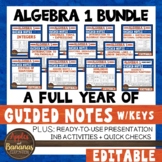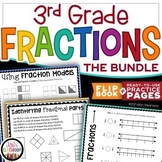27 results
High school statistics simulation microsofts
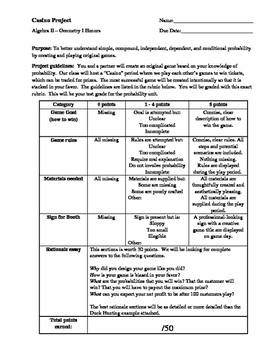
Carnival Probability Project
A project that feels like a game!
Students must create their own game, using probability to ensure THEY are favored to win....much like the house in a casino. Students can make games involving dice, spinners, cards, "fishing" ducks out of a pond, etc.
Assessed skills include: fundamental counting principal, theoretical probability, experimental probability, independent events, dependent events, creativity, writing, presentation. *Students must already know basic probability to complete this
Subjects:
Grades:
8th - 12th
Types:
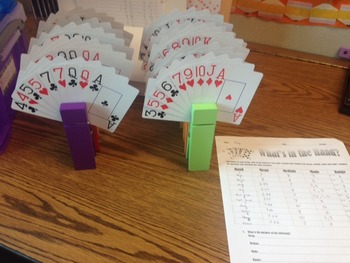
Statistics Mode, Median, Mean, Range Worksheet for Math or Psychology
What's in the Hand: Activity makes learning mode, median, mean, and range fun. You will need two packs of playing cards in order to use 10 different variations. I use giant clothes pins to hold a total of 9 cards for each station. Each student gets a worksheet and is assigned to a group of 4-5 students. Students will complete the first rotation by figuring the mean, median, mode, and range, and then rotate to each other station in about 5 min intervals. At the end they will answer the questions
Subjects:
Grades:
5th - 12th
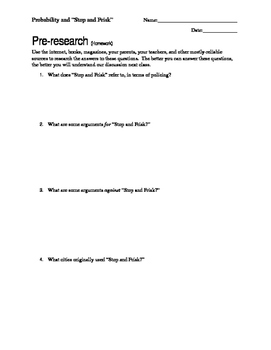
Using Probability to Teach Social Justice
This is an exploratory experiment/activity about basic probability. Students discover the differences between theoretical probability, experimental probability, and reality by taking a hard look at Stop and Frisk in urban areas. Students also deal with independent and dependent events.
By the end of the project, students will be able to:
Articulate the differences between theoretical and experimental probability through prediction and experimentation.
Articulate the differences between indep
Subjects:
Grades:
8th - 12th
Types:
CCSS:
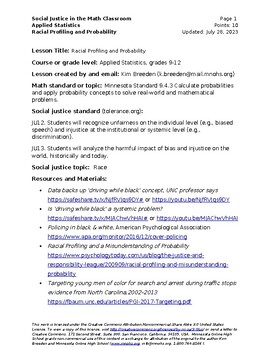
Racial Profiling and Probability (Social Justice Math)
In this assignment, you will investigate racial profiling, or Driving While Black (DWB). African Americans and Latinos/as have complained, filed suit, and organized against what they believe are racist police practices—being stopped, searched, harassed, and arrested because they “fit” a racial profile—they are African American (Black) or Latino/a (Brown). But is this true? How do we know? And can mathematics be a useful tool in helping us answer this question?These questions will be answered usi
Subjects:
Grades:
7th - 12th
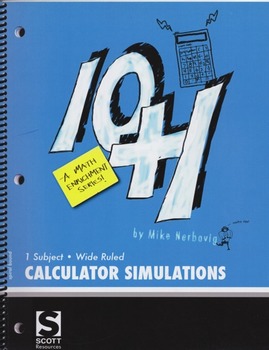
Calculator Simulations for Probability and Statistics
If you are obliged to follow a mandated math curriculum at your school, then I suggest you read no further because this site is probably not suitable for you. However, if you are looking for something that is different, yet might spark an interest in either you or your students, then it might be worthwhile for you to continue reading.In 1994 I wrote an alternative curriculum for our Probability and Statistics students that employed Monte Carlo simulations. The students’ reactions were so positi
Subjects:
Grades:
10th - 12th
Types:
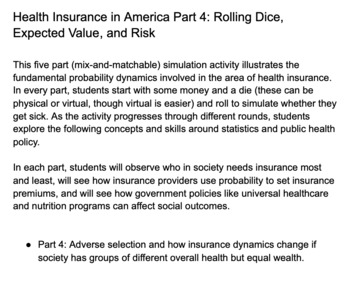
Health Insurance in America Part 4 (Activity and Teacher Guide)
Health Insurance in America Part 4: Rolling Dice, Expected Value, and RiskThis five part (mix-and-matchable) simulation activity illustrates the fundamental probability dynamics involved in the area of health insurance. In every part, students start with some money and a die (these can be physical or virtual, though virtual is easier) and roll to simulate whether they get sick. As the activity progresses through different rounds, students explore the following concepts and skills around statisti
Subjects:
Grades:
9th - 12th
Types:
CCSS:
Also included in: Simulating Health Insurance in America: Full Activity and Teacher Guide
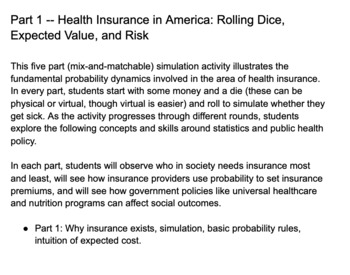
Health Insurance in America Part 1 (Activity and Teacher Guide)
Part 1 -- Health Insurance in America: Rolling Dice, Expected Value, and RiskThis five part (mix-and-matchable) simulation activity illustrates the fundamental probability dynamics involved in the area of health insurance. In every part, students start with some money and a die (these can be physical or virtual, though virtual is easier) and roll to simulate whether they get sick. As the activity progresses through different rounds, students explore the following concepts and skills around stati
Subjects:
Grades:
9th - 12th
Types:
CCSS:
Also included in: Simulating Health Insurance in America: Full Activity and Teacher Guide

Health Insurance in America Part 1: Probability, Expected Value, and Risk
Health Insurance in America: Rolling Dice, Expected Value, and RiskThis five part (mix-and-matchable) simulation activity illustrates the fundamental probability dynamics involved in the area of health insurance. In every part, students start with some money and a die (these can be physical or virtual, though virtual is easier) and roll to simulate whether they get sick. In each part, students will observe who in society needs insurance most and least, will see how insurance providers use probab
Subjects:
Grades:
9th - 12th
Types:
CCSS:
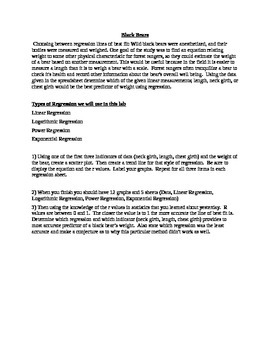
Comparing Linear, Quadratic, Exponential Regressions w/Spreadsheets
This project incorporates spreadsheets with scatter plots and lines of best fit. It asked students to perform various regressions, such as linear, power, exponential, and logarithmic, The students are asked to generate an model to help park rangers determine the weight of black bears by using only one of three measures, neck girth, length, and chest girth. Calculating the bears weights allow the rangers to anesthetize them in order for them to care for the bears. The r values in this project
Subjects:
Grades:
9th - 12th
Types:
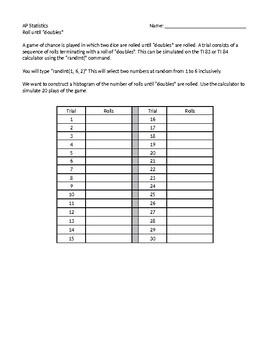
AP Statistics: Rolling Doubles Activity
Students use the random number generator on their calculators to simulate dice rolls. Students graph and describe the results. Students answer follow-up questions regarding mean versus median as well as the expected value.
Subjects:
Grades:
10th - 12th
Types:
CCSS:
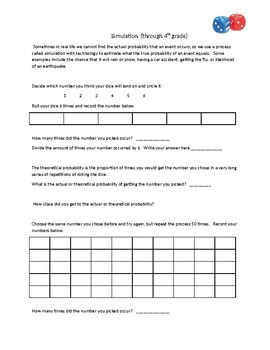
Probability Intro to simulation using dice
This is the perfect introductory activity to simulation and probability. It could be used in Algebra 2 and basic Statistics courses. It could also be used in 6th through 8th grade to introduce probability.
Subjects:
Grades:
6th - 12th
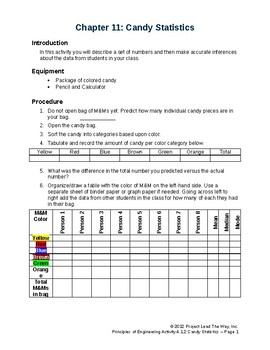
Candy Statistics
Kids have a chance to open individual bags of M&Ms and practice calculating probability of different colors and solving probability problems both independent and dependent.
Subjects:
Grades:
9th - 12th
Types:
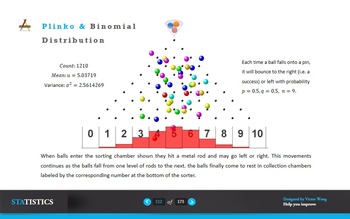
Binomial Distribution
• use formulae for probabilities for the binomial distribution, and
recognise practical situations where the binomial distribution is a
suitable model (the notation B(n, p) is included);
• use formulae for the expectation and variance of the binomial
distribution.
Subjects:
Grades:
10th - 12th, Higher Education, Staff
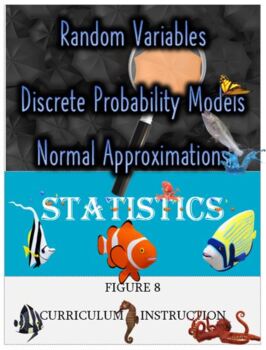
Snack Cakes: Group Task Random Variables_Discrete Var_Normal Approx. (editable)
Group Task Involving CAKE!!!!Targeted Skills:1. Interpret Statistical Calculations2. Determine Models and Parameters3. Assign Meanings and Assess Claims4. Determine Calculations Targeted Topics:1. Random Variables and Combinations2. Probability Distributions-Binomial and Geometric3. Mean and Standard Deviation of Random Variables4. Normal Approximations for Binomial DistributionsWhat is Included in this document?1. Task2. Sample Solution with Point Values and Scoring Guide3. Directions for imple
Subjects:
Grades:
9th - 12th, Higher Education, Adult Education

Normal Distribution
1)understand the use of a normal distribution to model a continuous
random variable, and use normal distribution tables;
solve problems concerning a variable X, where X ~ N, including:
finding the value of P(X > x1), or a related probability, given the
values of x1,
2)finding a relationship between x1, and given the value of
P(X > x1) or a related probability;
3)recall conditions under which the normal distribution can be used
as an approximation to the binomial distribution (n large enou
Subjects:
Grades:
10th - 12th

Health Insurance in America Part 2 (Activity and Teacher Guide)
Part 2 -- Health Insurance in America: Rolling Dice, Expected Value, and RiskThis five part (mix-and-matchable) simulation activity illustrates the fundamental probability dynamics involved in the area of health insurance. In every part, students start with some money and a die (these can be physical or virtual, though virtual is easier) and roll to simulate whether they get sick. As the activity progresses through different rounds, students explore the following concepts and skills around stati
Subjects:
Grades:
9th - 12th
Types:
CCSS:
Also included in: Simulating Health Insurance in America: Full Activity and Teacher Guide
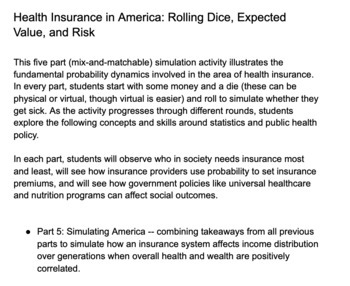
Health Insurance in America Part 5 (Activity and Teacher Guide)
Health Insurance in America: Rolling Dice, Expected Value, and RiskThis five part (mix-and-matchable) simulation activity illustrates the fundamental probability dynamics involved in the area of health insurance. In every part, students start with some money and a die (these can be physical or virtual, though virtual is easier) and roll to simulate whether they get sick. As the activity progresses through different rounds, students explore the following concepts and skills around statistics and
Subjects:
Grades:
9th - 12th
Types:
CCSS:
Also included in: Simulating Health Insurance in America: Full Activity and Teacher Guide
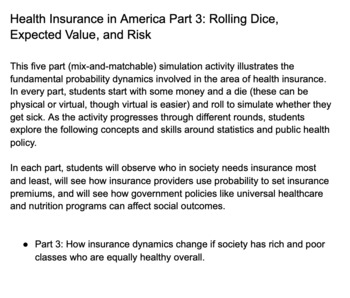
Health Insurance in America Part 3 (Activity and Teacher Guide)
Health Insurance in America Part 3: Rolling Dice, Expected Value, and RiskThis five part (mix-and-matchable) simulation activity illustrates the fundamental probability dynamics involved in the area of health insurance. In every part, students start with some money and a die (these can be physical or virtual, though virtual is easier) and roll to simulate whether they get sick. As the activity progresses through different rounds, students explore the following concepts and skills around statisti
Subjects:
Grades:
9th - 12th
Types:
CCSS:
Also included in: Simulating Health Insurance in America: Full Activity and Teacher Guide
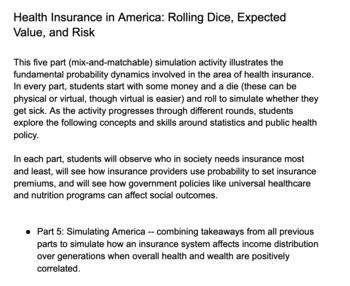
Health Insurance in America Part 5: Probability and Simulated America
Health Insurance in America Part 5: Simulated AmericaThis five part (mix-and-matchable) simulation activity illustrates the fundamental probability dynamics involved in the area of health insurance. In every part, students start with some money and a die (these can be physical or virtual, though virtual is easier) and roll to simulate whether they get sick. As the activity progresses through different rounds, students explore the following concepts and skills around statistics and public health
Subjects:
Grades:
9th - 12th
Types:
CCSS:
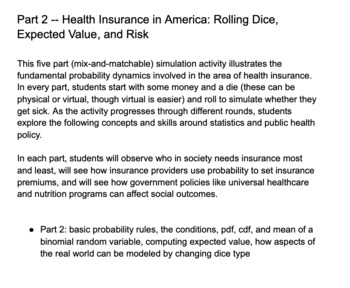
Health Insurance in America Part 2: Probability Rules and Binomial Distribution
Health Insurance in America Part 2: Rolling Dice, Expected Value, and RiskThis five part (mix-and-matchable) simulation activity illustrates the fundamental probability dynamics involved in the area of health insurance. In every part, students start with some money and a die (these can be physical or virtual, though virtual is easier) and roll to simulate whether they get sick. As the activity progresses through different rounds, students explore the following concepts and skills around statisti
Subjects:
Grades:
9th - 12th
Types:
CCSS:
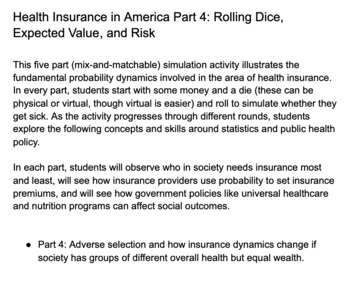
Health Insurance in America Part 4: Probability and Adverse Selection
Health Insurance in America Part 4: Rolling Dice, Expected Value, and RiskThis five part (mix-and-matchable) simulation activity illustrates the fundamental probability dynamics involved in the area of health insurance. In every part, students start with some money and a die (these can be physical or virtual, though virtual is easier) and roll to simulate whether they get sick. As the activity progresses through different rounds, students explore the following concepts and skills around statisti
Subjects:
Grades:
9th - 12th
Types:
CCSS:

Health Insurance in America Part 3: Probability, Insurance, and Wealth
Health Insurance in America Part 3: Rolling Dice, Expected Value, and RiskThis five part (mix-and-matchable) simulation activity illustrates the fundamental probability dynamics involved in the area of health insurance. In every part, students start with some money and a die (these can be physical or virtual, though virtual is easier) and roll to simulate whether they get sick. As the activity progresses through different rounds, students explore the following concepts and skills around statisti
Subjects:
Grades:
9th - 12th
Types:
CCSS:
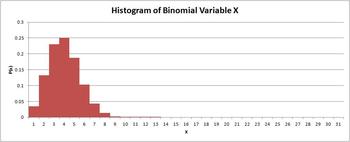
Normal Approximation to the Binomial Demonstration
This interactive Excel worksheet uses a histogram to demonstrate to students the conditions under which a normal distribution can be used to approximate binomial probabilities. Users can change the values of n and p, and the histogram will update automatically. The binomial probabilities are also updated with each change. Students will be able to clearly see when the histogram approaches a mounded and symmetric distribution. The bars of the histogram are wide enough for students to be able t
Subjects:
Grades:
9th - 12th, Higher Education
Types:
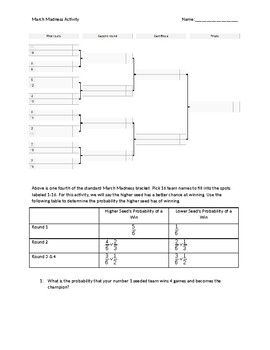
March "Math"ness Probability
I designed this activity to show how likely making a perfect bracket really is. It engages students in a fun probability activity where they can calculate a probability and also see probability in action. Students have to pick 16 teams (real or fictional) and determine who they think the winners will be in each game. After answering a few probability questions, they will use a die to determine the winners of each game. Then they will see if they would have won a bracket challenge.
Subjects:
Grades:
9th - 12th
Showing 1-24 of 27 results


